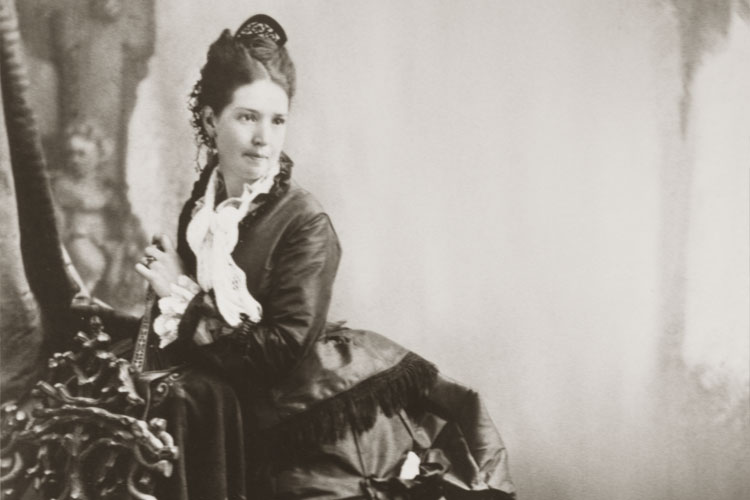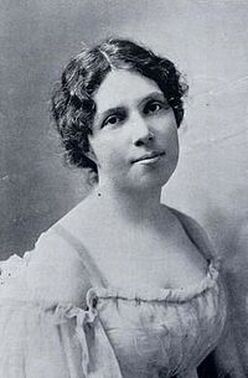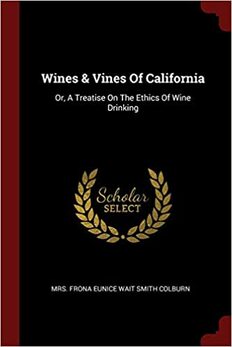n
During conversation Ron told us about a presentation he would be giving the following month to a group celebrating the 100th anniversary of the San Francisco Girls Chorus. The title of his talk was “Prohibition, Suffrage, and Early Women Winemakers in 19th and 20th Century America.” The information Ron shared with us based on his research was amazing. Other than Lilly Langtry and Isabelle Simi, I had never heard of any of the women, all of whom owned and ran wineries. Perhaps there’s a good reason why. These women were not especially supportive of the Suffrage movement. That may seem shocking, but it’s important to know that in the latter half of the 19th and early 20th centuries, the Suffrage and Prohibition movements were linked. It’s a complex story and some background is needed to understand how these two very different movements came to be unified.
The following is taken from a transcript of Ron’s presentation. I have edited it for length but the content is taken entirely from his narrative which unified the work of many fine historians and their research.
“Prohibition, Suffrage, and Early Women Winemakers in the 19th and 20th Century America.”
By Ron Merlino
The last few years have celebrated the hundredth anniversaries of the 18th and 19th amendments enacting Prohibition and granting women the right to vote, respectively. What few today realize is that both movements were indelibly linked – each could not have occurred without the other. Their story is a truly American one – a tale of immigration, cultural diversity, civil liberty, human rights, and religion. They are also a reminder to us all of racism, isolationism, xenophobia, and corruption. To fully understand this, it is necessary to view the key events that preceded the passing of these two amendments.
1848-58: The gold rush brings thousands to California, including immigrants from every corner of the globe and scores of Americans from the East Coast and the Midwest.
1865: With the end of the Civil War, the 13th Amendment is ratified abolishing slavery.
1868: The 14th amendment passes, granting freed slaves and their descendants citizenship rights.
1869: The Transcontinental Railroad is finally completed – a huge achievement that required the labor of freed slaves. Massive speculation and investment in the West ensued and many businesses overextended their resources and capacity.
1870: The 15th amendment grants black men the right to vote.
1873: On May 9th the Vienna Stock Market crashes. By Sept 20th the New York Stock Exchange had closed its doors for 20 full days. By Thanksgiving, three quarters of the newly formed railroad companies in the US cease operations due to over-speculation in the West. The first global world financial crisis ensues – the Panic of 1873.
1873: On Dec 23rd, the first Women’s Christian Temperance Conference was held in Hillsboro, Ohio. It was fueled by frustration and pent up anger over the rising tide of alcoholism and the violence that alcohol encouraged men to perpetuate against women. But it was also the inevitable end result of women having watched the rights of blacks and freed slaves find a legal voice before their own, movements they had supported but which still left them disenfranchised.
It is not by chance that this first Conference took place only miles away from the well-known wine country of the Ohio River Valley – the Cincinnati vineyards that had defined the face of American wine culture to that point in history.
The Temperance women opposed the Northern Republican party’s dominance of national politics. They published pamphlets claiming women’s moral superiority to men, espousing that a man’s only hope to rise to a woman’s higher moral ground would be to reject alcohol, tobacco, and lust.
Southern Democrats watched this Temperance movement carefully, cleverly adopting the platform of National Prohibition. Not only could banning alcohol allow them to enforce their continued oppressive and isolationist policies, but it could now help them regain control of the national government. What began as a worthy idea among responsible women who actually believed that wine was to be encouraged over hard liquor–NOT that all alcohol should be banned– morphed into a frenzy of extremist Temperance crusades, a social wave that conservative-minded businessmen and politicians co-opted for their own motives.
1909: The 16th amendment establishes a Federal Income Tax. Overnight the alcohol tax as an important source of federal government revenue vanished and the way was paved for national Prohibition to become a reality.
Naturally, many men and women resisted this push to take away their freedom to drink. In those long, tortuous final ten years leading up to 1919, the savviest politicians understood that Prohibition as an amendment could not pass without the grassroots community efforts of the suffragettes who raised their voices to pressure hesitant and undecided women. In the end, it worked. A woman’s right to vote would be publicly tied to the passing of Prohibition.
But success had a dear and lasting price, for not all women were lockstep in unison by any means. Many women wanted the freedom to serve and to be served alcohol, and a small courageous group of them actually owned wineries and made wine. California emerged as a hot bed of anti-suffrage sentiment among women as a result of its economic significance in the wine trade. Famous California wine women like Lilly Langtry actually stepped away from her initial support of the suffrage movement. Other notable figures such as Isabelle Simi actively circumvented the law and blatantly defied the Prohibition regulations. But the true pioneers were left forgotten, perhaps because of their uncomfortable place in the otherwise moral triumph of Suffragism in America. This is their story.
Hannah Weinberger
John Weinberger was a businessman and winemaker from Germany who had emigrated to America in 1848. He first learned the wine trade working at Nicholas Longworth Vineyards in Cincinnati. John met his wife Hannah in Ohio, and the two moved west during the Gold Rush Years. Once in California, John quickly excelled as a wine producer in St. Helena. He also became president of the local Bank of St. Helena and was known as a close friend to two other German wine pioneers in Napa; Jacob Beringer of Beringer Vineyards and Jacob Schram of Schramsberg.
At the time, the JC Weinberger wines were considered equals to those of Beringer and Schram. The Weinberger brand and story are only forgotten today due to John’s untimely death in 1882, when he was gunned down in broad daylight on the platform of the St. Helena railroad station by a disgruntled employee.
Upon John’s death, Hannah took over running the winery. She also assumed John’s post as head of the bank. Hannah quickly established a national presence for her wines and successfully marketed them in major cities including St Louis, Cincinnati, and New York.
In 1889 her Cabernet Sauvignon was entered in the Paris World Expo. It won a silver medal, not only making her the first woman winemaker from the United States to be given an award on the world stage, but the first California wine to ever be awarded an international medal.
Hannah’s winery remained prosperous until 1920 when it was forced to close due to Prohibition. She passed away at the age of 91. Today her vineyards are part of the William Cole winery holdings across Highway 29 from the Markham winery.
Josephine Tychson
If you run a Google search for “pioneer California women winemakers,” Josephine Tychson’s name will probably come up first. After losing her husband to suicide during his battle with tuberculosis, Josephine undertook an extensive rebuilding of his winery and oversaw the very first harvest. She kept the business alive until 1895 when she decided to sell it to the then burgeoning giant Italian Swiss Colony. The winery, located near St. Helena, still stands today as part of Freemark Abbey Wines. The vines surrounding her original home are used to produce the Tychson Vineyard Cabernets made by Ann Colgin.
Aside from Hannah Weinberger and Josephine Tychson, the earliest pioneers of women in California wine were not from Napa—they were from Sonoma. Though they have been largely forgotten, their legacy is remarkable. Eliza Shaw Hood, Ellen Stuart, and Kate Warfield all hailed from Glen Ellen. All three lived and worked near one another, and all three took over the wineries owned by their respective husbands in the late 1870s and early 1880s.
Eliza Shaw Hood
Eliza Shaw Hood and her husband William Hood settled the area of Glen Ellen in 1848. Previously, William Hood had come from Scotland and was a carpenter by trade. He made a fortune during the urban boom of San Francisco following the Gold Rush. In 1851 he purchased a 30 square mile tract of land called Rancho Guiluco on which stood a mountain that is named after him (Mt. Hood).
Unfortunately, William was committed to a local asylum in later years, and Eliza took over the winery in 1877. That date makes her the first and earliest known woman to run a winery in California. At the time the estate vineyard was planted entirely to the Mission grape. Eliza hired Auguste Drioton, a French viticultural expert who had previously published a book on the handling of phylloxera. With his help, she grafted the vineyard over to a wide variety of vitis vinifera.
The Eliza Hood Cabernets, Rieslings, and Semillons became widely acclaimed and her brandy was successful as well. Over time, production increased to over 100,000 gallons of wine and 5,000 gallons of brandy. In 1897 she too sold her winery to the Italian Swiss Colony and then moved to San Francisco where she lived until 1918.
Ellen Stuart
Ellen Stuart also married a Scotsman, Charles Stuart. Like the Hoods, they came to Sonoma at the peak of the Gold Rush in 1849. Charles bought a 1000-acre land grant called Agua Caliente that ran parallel to today’s Highway 12. He planted vines and named the estate Glen Ellen to honor of his wife and Scottish heritage. The Stuart estate was one of the first vineyards in the region. By 1863 there were 40 acres planted, and in 1869 a stone winery house was built that still stands. In 1880 Charles died suddenly and Ellen found herself supervising the crush of the now 90-acre vineyard. Over the next decade she made and marketed the estate’s wines until phylloxera devastated the vineyard in 1890. Given the time frame, one can make the argument that Ellen Stuart was the earliest known woman winemaker in California.
Kate Warfield
Kate Warfield was known as the “lady vineyardist” in her time. Her husband Jacob Warfield came to California from Ohio in 1849 and built a successful trading business in Gold Country. When Charles and Ellen Stuart sold him part of their estate in 1862, Jacob named the winery Ten Oaks and planted 16 acres of Mission vines. After his after his death in 1878, Kate took over the vineyard and winery operation. She hired a French winemaker and grafted the Mission vines over to other European varieties.
In 1883 Kate entered her brandy in the California State Fair contest and won top prize. However, the result was contested by an all-male judging panel who believed it impossible that a woman could make a better brandy than a man. A second testing was held on the spot and yielded identical results.
In 1886 Warfield was awarded top marks for her Cabernet, Syrah, and Sauvignon Blanc at the San Francisco Mechanics Fair Tasting, the preeminent California wine event at the time. She also became widely known as an advocate for phylloxera-resistant root stocks and was considered the most talented vine grower in California in her time.
The success of these three women is remarkable. However, there’s more to their story. Together, they brought a legal petition to the Sonoma County Superior Court in the early 1880s. In the petition they argued for the right to operate their wineries as “sole traders,” a legal designation necessary to run a commercial business in the state of California. At the time, the sole trader status was rarely granted to women. However, by sheer force of will, courage, and intellect they won their case and gained the right to operate as female proprietors of their estates.
While it’s far from a thrilling plot line, this singular achievement set the stage for women in the industry who would follow in the coming decades. The Sonoma Trio were not only true pioneers for women’s rights, they also paved the way for women winemakers in America.
Finally, the brilliant journalism of Frona Eunice Wait, without whom most of the written history described above would have been lost. Wait was born in the gold rush territory in 1859. Early on she displayed a gift for journalism, landing her first job with the Santa Rosa Republican. Her talents were soon noticed by William Randolph Hearst and in 1887, at age 28, she was hired by Hearst as the first female staff journalist for the San Francisco Chronicle and Examiner newspapers.
Two years later Wait published the first of two seminal books on the California wine industry: Wines and Vines of California: A Treatise on the Ethics of Wine Drinking (1889). It was immediately hailed as a definitive contemporary work on California wine. In writing the book, she interviewed every winemaker she could find, visiting vineyards, cataloguing grape varieties, explaining production methods, and listing the unique accomplishments of each and every vintner and producer. It’s only because of her work that we have such a vivid and accurate picture of what wine in California was actually like at the time. Wait went on to publish a second book on California wine, as well as a book on Spanish wine and several other history works. In 1897 she published a novel, Yermah the Dorado, which many consider to be the very first science fiction work ever written.
With the mention of “ethics of drinking” in the title of her first book, it comes as no surprise that Ms. Wait was an avid anti-Suffragist and anti-Prohibitionist. She actively campaigned against both initiatives. Her pamphlet, 80 Percent of the Women in California Do Not Want the Vote, was printed in 1915 at the height of the resistance efforts to both amendments. The work was immensely popular and reprinted and distributed on the East Coast and across the South.
Wait’s writing is full of life and teems with character even when focused on mundane things such as soil and vines. She is truly one of the great—and controversial–figures of California wine in the early 20th century. Today Wait reminds us that there are many hidden, yet extraordinary women in the history of American wine in the challenging and profoundly important years leading up to Prohibition and Women’s Right to Vote. And that the story is never black and white but rather full of shades and nuances. Most importantly, the story of women in California wine history deserves a great deal more attention, advocacy, and voice–even if it doesn’t fit comfortably into the accepted narrative as we have come to know it. But it’s truly an American story; one of courage and belief in one’s convictions, one of innovation and creative spirit, and one of conflict and challenge. Thanks to Wait’s work we have the opportunity to raise our glasses to these unheralded women and know that their legacies will live on.
nn


